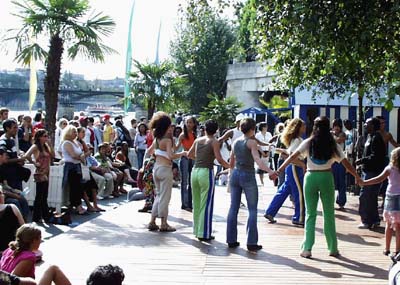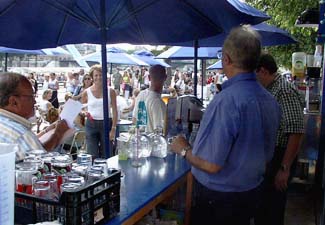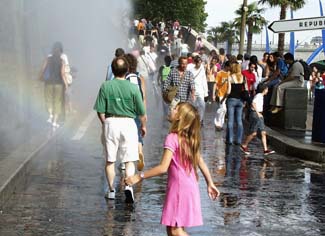
|

|
PARIS, Sunday, July 24,
2005
The aftermath of war lasted a long time, until Parisians began to think it was time to banish the dirt by tearing
down the central market of Les Halles and get rid of the crabbed traffic by putting a speedway right through the center along
the Seine. For good measure the ugly tower at Montparnasse was tossed up but then Georges Pompidou died and the speedway named
after him stayed half finished, being speedy only along the right bank from west to east.
When I lived out in a western
suburb I could take the autoroute to the edge of town and then catch the speedway and ride along the river past the Eiffel
tower. I could roll non-stop from my village to the center of Paris and park near Notre Dame. It's a bit like living in Nassau
county and parking within a block of Times Square. It worked like a charm on Sundays, about twice as fast as the train and
much cheaper.
If you live in Paris you probably won't use the speedway because you can take the Métro and not worry
about parking. If you live in Paris you might not care that the speedway is a convenience for drivers with a good view for
them. You might be annoyed that this same good view is full of their metal and glass and rubber, exhaust fumes, and sometimes
bad tempers.
In 2001 the new city government decided to turn three kilometres of the speedway into a temporary beach.
Paris has long had a notion that the beach was just under its paving stones, as in, 'it could be the Mediterranean here if
we dream hard enough.' Graffiti in east Paris has long insisted that the beach is underfoot.
In 2001 they laughed
at the beach called Paris-Plage. Motorists, who had been looking forward to fast summertime runs through the city, were furious.
The beach had a few potted palms, a little sand and no swimming. If you could overlook the drabness, and the lingering stench
of rubber and gas, it was beside the river and it had those views - Pont Neuf, the Ile de la Cité, the Conciergerie, Notre
Dame and the Ile Saint Louis - and it was free.
People who can afford to become sardines and grill on the Riviera
probably still laugh. Other cities have done theirs, such as Brussels les Bains, Berlin by the Spree, and Rome along the Tiber.
Elsewhere in France there are urban beaches in Toulouse, Dijon and Saint-Quentin. This year Tokyo opens its version in Shibuya.
Is it fake, is it phony? As much as Paris likes to think that it is Mediterranean in character, the weather is usually
against it. There can be days of brilliant blue skies and sunshine but these are usually random and are just as likely in
February as in July, which means not very. Even cities with beaches seldom have them in the center of town.
In Europe
it is not exactly normal to put on a Hawaiian shirt, grab a towel and go downtown on the Métro to catch the sun. But the city,
this crazy place, has laid out 1500 tons of fine sand, hundreds of deckchairs and hammocks, stuck in a lot of nifty palms,
put up a real swimming pool, installed fog machines and showers and added solar-powered fairy lights for the evenings.
The formula of past
years stays the same with additions, such as a touch of Brazil for color, music and samba, more beach sports, a floating restaurant,
outdoor movies on Tuesdays, a beach area just for little kids, and expanded ferry services, reaching out to Boulogne in the
west and Charenton to the east.
Returned to the summer rendez-vous are the pétanque and peteca areas, the sand sports
in front of the Hôtel de Ville, the Fnac concert stage, bike rentals, gymnastics, five beach cafés, the snack and ice cream
stands, and the services like information, first-aid, postal, and security, all open from 7 am to midnight.
For the
third edition last year the city estimated that 3.8 million beach fans were attracted to the 3.5-kilometre site, which was
a near saturation level. This year the city was involved with its - failed - Olympic bid but is planning for expansion next
year when a full-sized floating pool is expected to be situated near the Biblilothèque Nationale on the Left Bank.
As
a summer visitor you can stand on the Pont de Notre Dame, on the trace of the Roman road to Soissons, and dither over whether
to see Notre Dame, Sainte-Chapelle, the Conciergerie - or further afield, the Louvre, the Opéra, the Eiffel tower or the Champs-Elysées.
Or you can see this color, these blue sails in the breeze, all along the Right Bank.
This is Paris-Plage. Narrow,
fake but less fake than it was, a beach of the imagination with real sand and European service. Even without swimming it has
lifeguards, without pedalos it has a floating restaurant, and you can get to it by Métro or ferryboat. It's enough to set
you dancing and Paris-Plage provides the music until Sunday, August 21.
|

|

|

|

|

|
At the plage:




|

|

|

